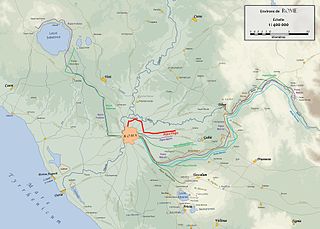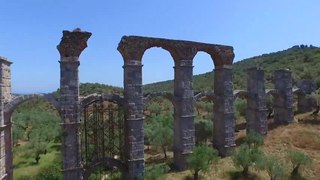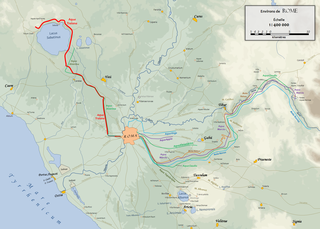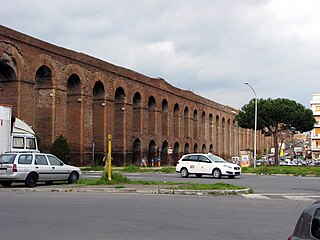Related Research Articles

The Aqua Appia was the first Roman aqueduct, constructed in 312 BC by the co-censors Gaius Plautius Venox and Appius Claudius Caecus, the same Roman censor who also built the important Via Appia.

The Aqua Virgo was one of the eleven Roman aqueducts that supplied the city of ancient Rome. It was completed in 19 BC by Marcus Agrippa, during the reign of the emperor Augustus and was built mainly to supply the contemporaneous Baths of Agrippa in the Campus Martius.

Acqua Vergine is one of several Roman aqueducts that deliver pure drinking water to Rome. Its name derives from its predecessor Aqua Virgo, which was constructed by Marcus Vipsanius Agrippa in 19 BC. Its terminal castellum is located at the Baths of Agrippa, and it served the vicinity of Campus Martius through its various conduits. In an effort to restore fresh water to Rome during the Renaissance, Pope Nicholas V, in 1453, renovated the main channels of the Aqua Virgo and added numerous secondary conduits under Campo Marzio. The original terminus, called a mostra, which means showpiece, was the stately, dignified wall fountain designed by Leon Battista Alberti in Piazza dei Crociferi. Due to several additions and modifications to the end-most points of the conduits during the years that followed, during the Renaissance and Baroque periods, the Acqua Vergine culminated in several magnificent mostre - the Trevi Fountain and the fountains of Piazza del Popolo.

The Romans constructed aqueducts throughout their Republic and later Empire, to bring water from outside sources into cities and towns. Aqueduct water supplied public baths, latrines, fountains, and private households; it also supported mining operations, milling, farms, and gardens.

Aqua Anio Novus was an ancient Roman aqueduct. Like the Aqua Claudia, it was begun by emperor Caligula in 38 AD and completed in 52 AD by Claudius, who dedicated them both on August 1. Together with the Aqua Anio Vetus, Aqua Marcia and Aqua Claudia, it is regarded as one of the "four great aqueducts of Rome."

Aqua Claudia was an ancient Roman aqueduct that, like the Aqua Anio Novus, was begun by Emperor Caligula in 38 AD and finished by Emperor Claudius in 52 AD.

The Aqua Julia is a Roman aqueduct built in 33 BC by Agrippa under Augustus to supply the city of Rome. It was repaired and expanded by Augustus from 11–4 BC.

The Acqua Felice is one of the aqueducts of Rome, completed in 1586 by Pope Sixtus V, whose birth name, which he never fully abandoned, was Felice Peretti. The first new aqueduct of early modern Rome, its source is at the springs at Pantano Borghese, off Via Casilina. Its length is fifteen miles (24 km), running underground for eight miles (13 km) from its source, first in the channel of Aqua Alexandrina, then alternating on the arches of the Aqua Claudia and the Aqua Marcia for seven miles (11 km) to its terminus at the Fontana dell'Acqua Felice on the Quirinal Hill, standing to one side of the Strada Pia, so as to form a piazza in this still new part of Rome. The engineer was Giovanni Fontana, brother of Sixtus' engineer-architect Domenico Fontana, who recorded that the very day the new pope entered the Lateran, he decided that he would bring water once again to the hills of Rome, which had remained waterless and sparsely inhabited, largely by monasteries, since the Roman aqueducts had been destroyed in the sixth century. From the source, which Sixtus purchased, there was only a very small fall, and the work required an underground conduit as well as an aqueduct carried on arches.

The Aqua Traiana was a 1st-century Roman aqueduct built by Emperor Trajan and inaugurated on 24 June 109 AD. It channelled water from sources around Lake Bracciano, 40 kilometers (25 mi) north-west of Rome, to Rome in ancient Roman times but had fallen into disuse by the 17th century. It fed a number of water mills on the Janiculum, including a sophisticated mill complex revealed by excavations in the 1990s under the present American Academy in Rome. Some of the Janiculum mills were famously put out of action by the Ostrogoths when they cut the aqueduct in 537 during the first siege of Rome. Belisarius restored the supply of grain by using mills floating in the Tiber. The complex of mills bears parallels with a similar complex at Barbegal in southern Gaul.

The Aqua Tepula is an ancient Roman aqueduct completed in 125 BC by censors Gnaeus Servilius Caepio and L. Cassius Longinus.
The Acqua Pia Antica Marcia or Aqua Pia was an aqueduct in Rome. It was first built as a restoration of the classical Aqua Marcia by Luigi Canina, commissioned by Pope Pius IX. Its city terminus was the Fountain of the Naiads in the Piazza Esedra.

In Ancient Rome, the Aqua Alsietina was the earlier of the two western Roman aqueducts, erected sometime around 2BC, during the reign of emperor Augustus. It was the only water supply for the Transtiberine region, on the right bank of the river Tiber.

The Aqua Alexandrina was a Roman aqueduct located in the city of Rome. The 22.4 km long aqueduct carried water from Pantano Borghese to the Baths of Alexander on the Campus Martius. It remained in use from the 3rd to the 8th century AD.

The Aqua Marcia is one of the longest of the eleven aqueducts that supplied the city of Rome. The aqueduct was built between 144–140 BC, during the Roman Republic. The still-functioning Acqua Felice from 1586 runs on long stretches along the route of the Aqua Marcia.

The Fontana dell'Acqua Felice, also called the Fountain of Moses, is a monumental fountain located in the Quirinale District of Rome, Italy. It marked the terminus of the Acqua Felice aqueduct restored by Pope Sixtus V. It was designed by Domenico Fontana and built in 1585–88.

The Fontana del Nettuno is a monumental fountain located in the Piazza del Popolo in Rome. It was constructed in 1822–23 at the terminus of a newly built aqueduct, the Acqua Vergine Nuovo. The fountains in the Piazza del Popolo were the work of Giovanni Ceccarini. The Fontana del Nettuno is located on the west side of the square, and shows Neptune with his Trident, accompanied by two Tritons.

The Fontana dell'Acqua Paola also known as Il Fontanone is a monumental fountain located on the Janiculum Hill, near the church of San Pietro in Montorio, in Rome, Italy. It was built in 1612 to mark the end of the Acqua Paola aqueduct, restored by Pope Paul V, and took its name from him. It was the first major fountain on the right bank of the River Tiber.
Acqua may refer to:

The Aqua Anio Vetus was an ancient Roman aqueduct, and the second oldest after the Aqua Appia. It was commissioned in 272 BC and funded by treasures seized after the victory against Pyrrhus of Epirus. Two magistrates were appointed by the Senate, the censors Manius Curius Dentatus and Flavius Flaccus.
References
- ↑ Bizzotto, Prof. Arch. Renata (Editor) & Mancuso, (With the cooperation of). "The post-unification aqueducts". www.architettiroma.it (in Italian).
{{cite web}}:|author=has generic name (help)CS1 maint: multiple names: authors list (link) - ↑ Bizzotto, Prof. Arch. Renata (Editor) & Mancuso, (With the cooperation of). "The post-unification aqueducts". www.architettiroma.it (in Italian).
{{cite web}}:|author=has generic name (help)CS1 maint: multiple names: authors list (link)